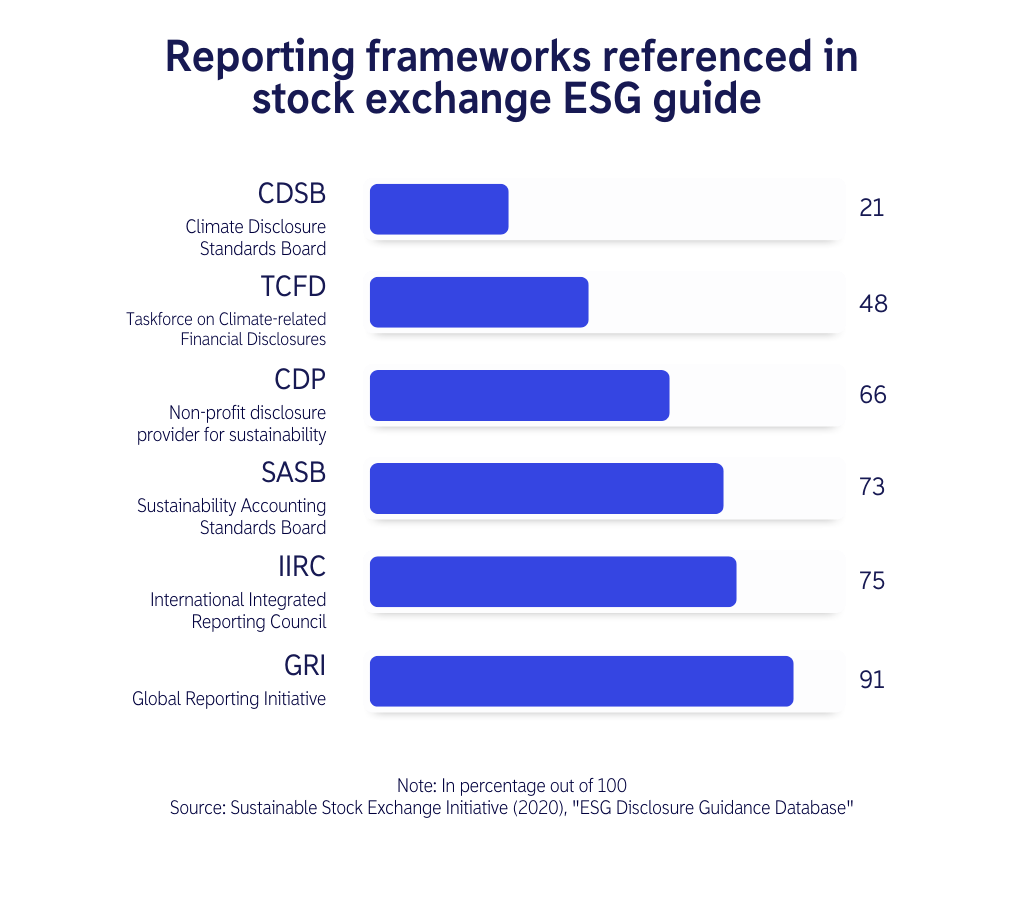ESG stands for “Environmental, Social and Governance.” ESG can be described as a set of practices (policies, procedures, metrics, etc.) that organizations implement to limit negative impact or enhance positive impact on the environment, society, and governance bodies.
In recent years, investors have become more aware of the importance of ESG criteria in their investment decisions. As a result, many businesses have begun to integrate ESG into their operations and business strategies.
Uncovering the meaning of ESG
What is the definition of ESG?
The ESG acronym stands for Environmental, Social and Governance. It refers to a set of non-financial measures that reflect a corporation’s impact on the environment and society.
ESG can be considered a subset of sustainability, which is defined by the UN World Commission on Environment and Development as ‘meeting the needs of present generations without compromising the ability of future generations to meet their own needs’.
Where does ESG come from?
The term ESG, or environmental, social and governance factors, was coined by the Global Compact in 2004.
However, the notion of incorporating all non-financial factors in business has been around for much longer; some might point to 2001 as the beginning of mainstream ESG with the launch of FTSE4Good indices.
While ESG influence has grown rapidly in recent years, sustainable investing is not a new concept.
Impact investing—the practice of making investments that generate not only financial returns, but also positive social and environmental impact—has its origins in religious groups who placed ethical parameters on their portfolios (refusing, for example, tobacco, alcohol, and gambling businesses).
How does ESG work?
ESG functions as a valuation technique that takes into account environmental, social and governance issues. ESG in the private sector is a set of criteria used to evaluate a company’s risks and practices.
ESG frameworks are important to sustainable investing because they can help individuals or other corporations determine whether the company is in alignment with their values, as well as analyze the ultimate worth of a company for their purposes.
The concept of responsible impact in business is not a new one, but has been gaining more widespread acceptance in the past few decades.
| Environmental factors | Social factors | Governance factors |
|---|---|---|
| Natural resource use | Workforce | Board independence |
| Carbon emissions | Human rights | Board diversity |
| Energy efficiency | Diversity | Shareholder rights |
| Pollution/waste | Supply chain | Management compensation |
| Environmental opportunities | Corporate ethics |
Source: ESG Rating providers, OECD, selected themes for illustration.
The importance of ESG for businesses and investors
Why adopt an ESG approach?
Risk Management and Adaptation for Investors
ESG covers issues that are, for the most part, longer-term considerations.
ESG risks are similar to other business risks in that it is important to understand, identify, quantify, and manage them, but certain ESG risks carry an added complication of being unpredictable.
For instance, the world is in uncharted territory with regards to climate and there is little relevant historical data to draw upon, since we are experiencing unprecedented changes. Thus, there is a need for investors to consider ESG criteria in their investment decisions.
Another characteristic of ESG risks is that they can be very costly.
To continue with the example of climate change, costs from climate change-related extreme weather ranks in the billions for each individual disaster. Therefore, while the cost of adaptation and mitigation can be substantial, the costs of uninsured losses far outweigh the cost of proactive mitigation.
Some examples of ESG risk management include assessing climate change risks to regular operations, assessing workplace culture, company diversity, etc.
ESG risk management supports sustainable, long-term growth by proactively evaluating potential issues; early knowledge of potential risk provides more time to adapt and develop cost-mitigating strategies.
The quality of a company’s ESG-related risk management is important to investors in weighing overall risk and return.
How to implement an ESG strategy?
Common ESG approaches for investors
There are four main ESG strategies in the field of investing that can help guide one’s understanding of ESG application:
- ESG integration refers to identifying ESG risks and implementing policies that will help set and achieve ESG goals. For investors, ESG integration often means defining the ESG criteria that will help assess and evaluate companies and their risk profiles. Note that ESG criteria can be tailored in-house to an individual company’s needs, or can be based on pre-set criteria from an extra-financial rating agency.
- Exclusionary screening rejects companies whose practices do not meet a certain standard.
- Inclusionary screening selects for companies that do meet a certain standard.
- Impact investing creates portfolios with the express aim of enacting positive, measurable environmental or social change, along with financial return (the desire for environmental and social benefit is built into the company purpose).
Most of the time, modern corporate ESG strategy will draw on elements of the four strategies, as each company tailors their ESG strategy to their unique strengths, weaknesses, opportunities, challenges, and timeline.
Guidelines for tailoring an ESG Strategy for companies
1. Identify the parties that will be responsible for implementation and oversight of the ESG program
Board involvement and managerial support is critical to creating value through ESG strategies. Active involvement by corporate boards can help guide and shape ESG best practices and reinforce the idea of the ESG strategy as a priority. Companies may also want to create an ESG team or committee, bring in staff experts, and/or write up a charter to stay on track.
2. Determine which ESG issues and data the company should focus on
Identifying specific ESG issues and metrics to focus on can be difficult, due to the diversity of ESG frameworks and lack of a universal standard. Nevertheless, ESG frameworks are systems meant to standardize the reporting of ESG metrics, so they are helpful starting points for figuring out key benchmarks and metrics. Some of the most commonly used ESG frameworks and standards include:
- Global Reporting Initiative (GRI)
- Carbon Disclosure Project (CDP)
- Climate Disclosure Standards Board (CDSB)
- Sustainability Accounting Standards Board (SASB)
- Task Force on Climate-related Financial Disclosures (TCFD)
- UN Principles for Responsible Investment (PRI)
- World Economic Forum (WEF) Stakeholder Capitalism Metrics

Some corporations may choose to rely directly on one of these frameworks; the benefit to that approach is that the benchmarks have already been established, and often already provide an ESG score based on fixed criteria that allows corporations to compare their performance with peers of similar scores.
If a company chooses to tailor its metrics, there are usually a few basic metrics that universally make sense for ESG performance (for example, energy and water consumption for Environmental considerations).
The selection of other metrics will depend on considerations such as: the priorities of the company’s stakeholders, the ESG goals that the company decided to focus on, the company’s ability to consistently gather good data on the topic, etc.
3. Set SMART goals
Once the contextual research has been completed, companies will need to set the goals that will become the company’s roadmap for ESG matters. Goals should be Specific, Measurable, Achievable, Relevant, and Time-Bound. These parameters will help set a clear timeline, and facilitate the tracking process.
4. Incorporate ESG practices into company culture
This step is rather long-term because it involves altering mindsets. Management and employees need to be trained and to buy into the ESG goals, and the company as a whole needs to continually work towards improving company culture and practices.
5. Produce ESG reports for stakeholders/investors/the public, and establish a consistent reporting procedure
In determining which ESG issues and metrics to report on, the company has already done part of the work.
Compiling the gathered information into an ESG report allows firms to spotlight their initiatives and successes, thereby demonstrating progress to their stakeholders.
Transparency through these reports also has the potential to boost employee morale; being able to see the impact of their day-to-day work can encourage even stronger buy-in for ESG goals.
ESG reports are often produced annually, but timeline and distribution method can vary from company to company; the key is to have a strong and consistent reporting process.
6. Ensure that public facing information is consistent with ESG disclosures
Companies must ensure that their ESG narrative aligns with the brand and the company’s vision and future direction.
Lip service and greenwashing without evidence to back up claims of adherence to ESG factors is arguably worse than doing nothing, because a lack of authenticity can erode consumer trust and do lasting damage to the company’s reputation.
The need for ESG only seems to be growing as society enters unprecedented times: climate change, protests and social upheaval, increasing technological capabilities, the ongoing COVID-19 pandemic.
The lack of existing data on the situations that we now face make clear a need for frameworks that can quantify and mitigate unpredictable risks. ESG strategies can help meet those needs, while providing some guidelines on how to build more resiliency into the corporate universe.
To conclude...
In conclusion, no company can prosper nowadays if it is not involved in the community and the people around.
Companies need to take an active role in the community, beyond just making a profit. The positive benefits of this strategy include the company’s expansion and durability of its success.
So, what are you waiting for? Start implementing ESG today!
And this is where we can help:
If you want to succeed in your sustainable journey… Save time, get organized, and stay compliant with our tool!
Thanks to our AI, apiday provides you with a simple and efficient process for your data collection, verification, reporting, and certification.
Get your organization started and book a call with our ESG experts!
Frequently Asked Questions
What is ESG?
ESG stands for Environmental, Social and, Governance, the factors companies integrate as part of their business strategy.
Why is ESG important?
Companies should be concerned with ESG because it helps them do business in a way that is more consistent and aligned with their values and their stakeholders’ expectations. This approach minimizes risk and can help them avoid reputational damage. A company’s ESG performance also affects its bottom line, its ability to secure funding or retain employees.
What is included under ESG?
The “E” captures energy efficiencies, carbon footprints, greenhouse gas emissions, deforestation, biodiversity, climate change and pollution mitigation, waste management and water usage.
The “S” covers labor standards, wages and benefits, workplace and board diversity, racial justice, pay equity, human rights, talent management, community relations, privacy and data protection, health and safety, supply-chain management and other human capital and social justice issues.
The “G” covers the governing of the “E” and the “S” categories—corporate board composition and structure, strategic sustainability oversight and compliance, executive compensation, political contributions and lobbying, and bribery and corruption.
Related articles
Global Reporting Initiative: What It Is and How to Do It
GRI stands for Global Reporting Initiative, and is an international independent standards organization that promotes sustainability reporting through the development of global standards for corporate responsibility, including environmental, social and governance (ESG) reporting...
Impact – What is Impact
The Corporate Sustainability Reporting Directive (CSRD) requires large businesses and SMEs to produce annual reports on their environmental and social impacts.
CSRD – What is CSRD
The Corporate Sustainability Reporting Directive (CSRD) requires large businesses and SMEs to produce annual reports on their environmental and social impacts.
Corporate Sustainability Reporting Directive: All you need to know
The Corporate Sustainability Reporting Directive is an EU regulation that will have a huge impact on how organisations report their environmental, social and governance (ESG) performance...
Sustainability – What is Sustainability
The GRI is an international independent standards organization and currently issues one of the most well-known standards for ESG reporting (GRI Standards).
Discover the latest Sustainability Recent Developments to improve your companies
Sustainability is a concept that evolves due to pressing sustainability challenges, worldwide issues, and its own concept limits. New concepts have emerged to think further and respond better to all the world’s current challenges...
GRI – What is the Global Reporting Initiative
The GRI is an international independent standards organization and currently issues one of the most well-known standards for ESG reporting (GRI Standards).
What is Materiality and Why it matters in business
Materiality is crucial for sustainability reporting because it allows companies to focus on the most important aspects of their sustainability efforts. A company can choose to report on all aspects of its sustainability program, but this would be extremely time-consuming and would probably not be very useful for investors and other stakeholders...
Materiality – What is Materiality
ESG is an acronym for Environmental, Social, and (Corporate) Governance. It refers to the non-financial factors of a corporation’s impact.
EcoVadis – What is EcoVadis rating
Created in 2007, EcoVadis provides a collaborative web-based rating platform for assessing the sustainability performance of organizations worldwide.
Impact-washing – What is Impact-washing
Impact washing can be defined as any marketing claim about a product/good/service/funds triggering a change in the real economy that cannot be supported by evidence.
ISO 26000 – What is ISO 26000
ESG is an acronym for Environmental, Social, and (Corporate) Governance. It refers to the non-financial factors of a corporation’s impact.
B Corp – What is B Corporation certification
ESG is an acronym for Environmental, Social, and (Corporate) Governance. It refers to the non-financial factors of a corporation’s impact.
The concept of impact on social and environmental issues and its implication for companies
Impact measurement is a powerful tool for companies to gauge their impact on social and environmental issues. In this article, we will discuss the concept of impact, its implications for organizations, and how it can be measured...
The most important and recent developments of ESG (Environmental, Social and Governance)
Being a B Corporation is not just about making profits and creating wealth for a company, it is a way of creating a more sustainable future for society! Discover our article about B corps and its benefits here...
The process for an enterprise to get the B corp certification
Becoming a B Corporation is an ambitious undertaking. This article will guide you through the steps required to become a B Corporation…
CSR – What is Corporate Social Responsibility
CSR is centered on the idea that businesses have a responsibility to benefit the society that they exist within—a broader view than the one that says businesses’ only responsibility is to produce economic profit.
What is a B Corporation: what this means and its benefits for companies
Being a B Corporation is not just about making profits and creating wealth for a company, it is a way of creating a more sustainable future for society! Discover our article about B corps and its benefits here...
The guide to EcoVadis certification: frequently asked questions
This guide will take you through the steps of the EcoVadis Certification process, and explain what is involved in becoming a certified business...
The implications of ISO 26000 for companies
ISO 26000 is a standard providing direction for the application of social responsibility to the activities of an organization. But what does this mean? And how can organizations use it to create better and more sustainable business practices? Let's talk about it…
What is the meaning of CSR (Corporate social responsibility) and how to adopt it?
A Corporate Social Responsibility strategy refers to an organization's active consideration of the effects its activities have on the environment, employees, customers, and suppliers. Let's look at how your company could adopt such a program...
ESG – What is Environmental, Social and Governance
ESG is an acronym for Environmental, Social, and (Corporate) Governance. It refers to the non-financial factors of a corporation’s impact.
4 reasons companies should adopt CSR, Corporate social responsibility
CSR is all about managing a company’s externalities while creating sustainable value for stakeholders and continuous innovation for the business. Let's break that down and explore why...
Carbon disclosure project reporting: what is it and how does it work?
Read our article about The Carbon Disclosure Project (CDP), an extra-financial questionnaire that collects data on companies’ environmental practices and performance...
What are the differences between Corporate Social Responsibility (CSR) and Environmental Social Governance (ESG)?
These terms are both used to describe an approach for businesses to integrate social and environmental factors into their governance policies, strategies, processes, and programs. Yet, they're not the same. Let's explore their key differences...













